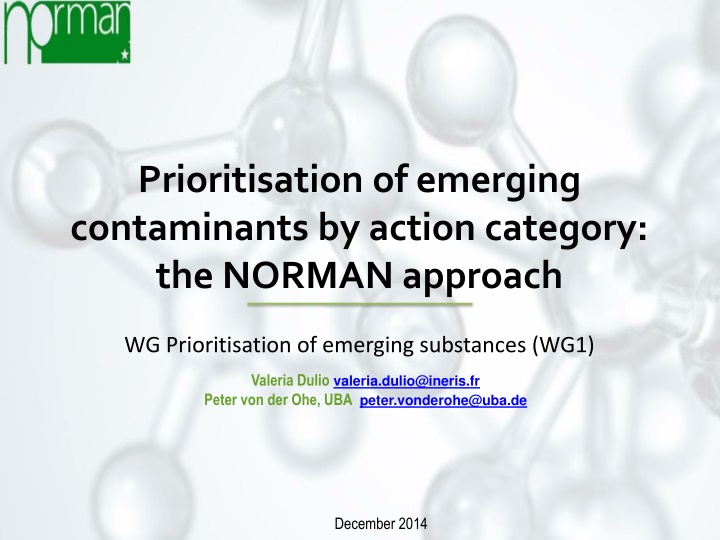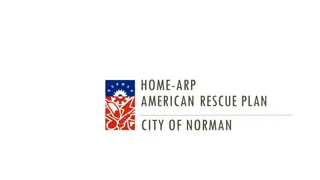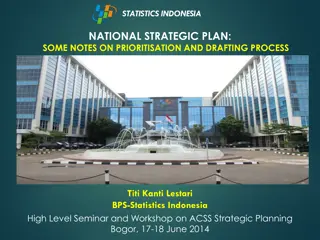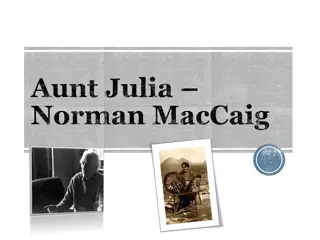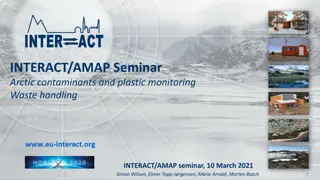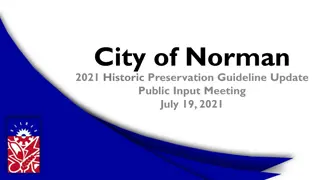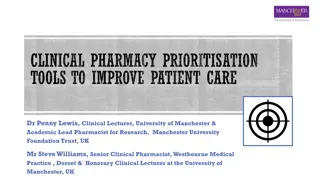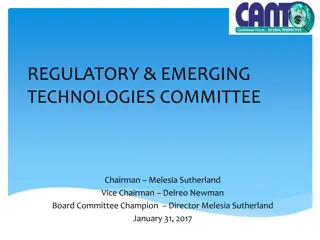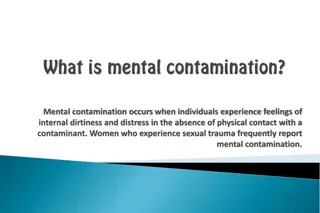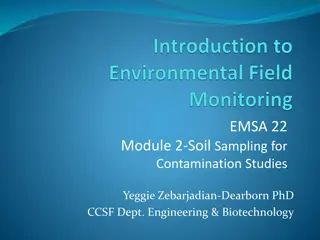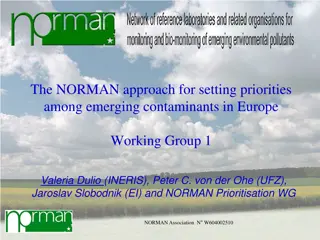Prioritisation of Emerging Contaminants: NORMAN Approach Overview
The NORMAN approach aids in prioritising emerging contaminants by categorising substances into action categories based on knowledge gaps and then prioritising them for further action. Typical steps involve choosing candidate substances, relevant parameters, using prioritisation algorithms, and addressing missing data through categorisation and prioritisation. Action categories include control measures, hazard assessment, analytical method improvement, and more. The overall approach includes data gathering, substance allocation, prioritisation, and review processes for effective management of emerging contaminants.
Download Presentation

Please find below an Image/Link to download the presentation.
The content on the website is provided AS IS for your information and personal use only. It may not be sold, licensed, or shared on other websites without obtaining consent from the author.If you encounter any issues during the download, it is possible that the publisher has removed the file from their server.
You are allowed to download the files provided on this website for personal or commercial use, subject to the condition that they are used lawfully. All files are the property of their respective owners.
The content on the website is provided AS IS for your information and personal use only. It may not be sold, licensed, or shared on other websites without obtaining consent from the author.
E N D
Presentation Transcript
Prioritisation of emerging contaminants by action category: the NORMAN approach WG Prioritisation of emerging substances (WG1) Valeria Dulio valeria.dulio@ineris.fr Peter von der Ohe, UBA peter.vonderohe@uba.de December 2014
NORMAN prioritisation scheme Designed for emerging substances Addresses knowledge gaps Identifies actions needed How does it work?
Typical steps / components of prioritisation schemes Choosing the candidate substances Choosing the relevant parameters for prioritisation PRIORITY Prioritisation algorithm Filling in the database Adapted from V. Bonnomet , 2006
What to do when data is missing ? ? Frequent conclusion of prioritisation exercises: A large number of chemicals could not be prioritised due to a lack of either hazard or exposure data (or both) (A. James. et al., 2009) 4
NORMAN approach: two main steps to tackle the problem of missing data 1. Categorisation of substances into action categories based on identified knowledge gaps 2. Prioritisation of substances within each category for further action
Categorisation of substances by identified knowledge gaps Subs.1 Subs.2 Subs.3 Subs.4 Subs.5 Subs.6 Subs.7 Subs.n Cat.1 Cat.2 Cat.3 Cat. n F. Botta, 2014
Action categories 1. Control / mitigation measures 2. Screening campaigns 3. Rigorous hazard assessment 4. Improvement of analytical methods 5. Screening AND hazard assessment 6. Reduced monitoring efforts
The overall approach List of candidate substances Data gathering, quality check, aggregation 1. Categorisation to allocate substances to action categories Exposure Effects Allocation to action categories 6 6 1 1 2 2 3 3 4 4 5 5 Prioritisation of substances within each category 2. Prioritisation to define priorities within each action category 6 6 2 2 1 1 3 3 4 4 5 5 Subst. prioritised by action category 1. 2. 3. . . . Actions implemented result in a new review process
LIST OF EMERGING SUBSTANCES (NORMAN list) 4 countries AND 100 sites with analysis 20 sites analysis > LOQ in the relevant matrix(ces) + Recent data (>last 6 years) ? Suff. monitored but low frequency of quantification Insuff. (or never) monitored OR monitored in wrong matrix Categorisation of substances Suff. monitored. & quantif. in relevant matrix LOQmax< PNEC (existing data in EMPODAT)? Sufficient experimental data for hazard assesment? yes yes no no LOQmin (EMPODAT) OR LOQ expert labs < PNEC ? yes Risk of exceedance of the Lowest PNEC ? no yes no Sufficient experimental data for hazard assesment? yes no Cat. 6: Non-priority for regular monitoring Cat. 1: Cat. 3: Action (eco)tox Priority regular monitoring Cat. 4: Action analytical Cat. 2: Watch list Cat. 5 Novel end points
Grouping of substances by degree of investigation and evidence of exposure at European level 4 groups identified : sufficiently monitored and sufficiently quantified in the relevant matrix sufficiently monitored in the relevant matrix, but with a low frequency of quantification insufficiently monitored never monitored (i.e. for which no data are available in the EMPODAT database or other existing datasets) monitored in a matrix that is considered as not relevant for the given substance
Applied criteria for exposure assessment at European level (ref. NORMAN Framework) Suff. level of investigation = Occurrence data available for : 4 countries AND 100 sites Sufficient evidence of exposure = Occurrence data available for : 20 sites with analysis > LOQ Measured in the relevant matrix Recent data (from 2005 in this exercise)
Grouping of substances by degree of investigation and evidence of exposure Indicators / Substances sub- groups Analyses available in the relevant matrix(ces) No. of countries with analyses No. of sites with analyses No. of sites with analyses > LOQ Subst. suff. Investig. and sufficiently quantif. in relevant matrix Yes >4 countries >100 sites >20 sites Subst. suff. investigated but with low frequency of quantification Yes >4 countries >100sites <20 sites (or all data <LOQ) Subst. insufficiently investigated Yes <4 countries AND / OR <100 sites with analyses Not relevant Subst. never investigated (i.e. data not available in EMPODAT DB) Not relevant No data No data No data Subst. investigated in non relevant matrix No Not relevant Not relevant Not relevant NORMAN Association N W604002510
Risk indicators Extent of Exceedance = MEC95 / Lowest PNEC to address the intensity of impact where: MEC95 (95th percentile of the max conc. at each site) Lowest PNEC Equivalent to PEC/PNEC! Score for Exceedance of environmental threshold MEC95/lowest PNEC <1 = 0 10 MEC95/lowest PNEC 1 =0.1 100 MEC95/lowest PNEC>10 = 0.2 1000 MEC95/lowest PNEC>100 =0.5 MEC95/lowest PNEC>1000 = 1
Risk indicators Frequency of Exceedance = n / N to address the spatial exposure aspects where: n is the number of sites with MECsite > Lowest PNEC N is the total number of sites where the substance was measured Score: value between 0 and 1 - Cat. 1, 3, 6: calculated using RECENT DATA - Cat. 2, 4, 5: calculated using ALL DATA (all YEARS)
Conclusions The NORMAN Prioritisation framework: is applicable at different geographical scales (European, national, river basin level) provides a decision-support framework for updating lists of substances for which actions (reduction, monitoring, research) are to be undertaken as a matter of priority Further improvement are under way as regards: Integration with chemical non-target screening and bioassays-based tools in order to improve the list of candidate substances Exposure index: introduction of a surrogate for missing monitoring data at EU level Going beyond PEC/PNEC ratios for individual substances
WG Prioritisation of emerging substances (WG1)
Leaders of the activity Working Group leader Ecotoxicity sub-group leader Valeria Dulio - INERIS, FR Peter C. Von der Ohe, UBA, DE Anja Derksen - AD eco advice, NL Ecotoxicity sub-group leader Working Group experts Stockholm University BRGM INERIS Recetox UFZ IVL University of Bordeaux KEMI PlasticsEurope VEOLIA Environnement EAWAG VEOLIA Environnement INERIS BfG T. G. Masaryk Water Research Inst. RIVM Recetox MUMM Fraunhofer-IME KWR UBA EI ONEMA Marlene gerstrand Laurence Amalric Sandrine Andres Ludek Blaha Werner Brack Eva Brostrom H l ne Budzinski Stellan Fisher James Franklin Armelle Hebert Juliane Hollender Val rie Ingrand Alice James-Casas Martin Keller Vera Ocenaskova Willie Peijnenburg Zuzana Rabova Patrick Roose Heinz Ruedel Merijn Schriks Dieter Schudoma Jaroslav Slobodnik Pierre-Fran ois Staub SE FR FR CZ DE SE FR SE EU FR CH FR FR DE CZ NL CZ BE DE NL DE SK FR
